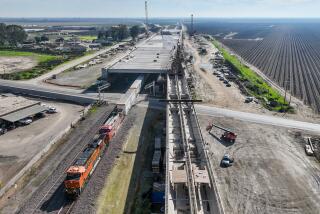FAA Analyzes Plan for El Toro Airport
- Share via
Orange County’s proposed airport at El Toro could be operated safely--but it would also create flight delays and inefficiencies across Southern California’s already crowded skies, according to the Federal Aviation Administration.
At times, as many as 24 flights arriving at John Wayne and Long Beach airports would be delayed by up to eight minutes to make room for each flight leaving El Toro to the north, according to the long-awaited analysis of the county’s plan, released Tuesday.
“The FAA has determined that the reuse of the former . . . El Toro [Marine base] as proposed by the [county] can be conducted in a safe manner,” the analysis said.
“FAA has further determined that the [county’s] proposal . . . limits the efficiency of the airport and may present impacts in the form of delays and decreased capacity to elements of the National Airspace System,” the report continued, striking a good-news, bad-news theme repeated throughout the 18-page document.
The report, which was to have been issued in April, comes a week before the county Board of Supervisors is scheduled to take its final vote on the airport plan.
Both sides of the debate said the report bolsters their arguments.
Airport supporters and county officials said the conclusions should squelch airport foes’ repeated claims that the county’s plan would be branded unsafe by the FAA because of the threat from surrounding hills and crowded skies.
“El Toro is safe as an airport,” said booster Bruce Nestande. “These other issues can be resolved and will be resolved.”
County airport planners said they anticipated that delays would result from fitting another major airport into Southern California, which has the second most crowded skies--behind New York-New Jersey--in the country. Even so, the county chose its airport layout to preserve noise buffer zones around the site, planners said.
“The delays at El Toro aren’t going to be any more or less” than at other regional airports, said Gary Simon, director of the county’s El Toro planning effort. “We’ve balanced efficiency with being a good neighbor. It’s worth it.”
But airport opponents said the analysis confirms that the county’s plan is flawed and would further strain an overtaxed regional air system. Furthermore, the FAA’s analysis examined how the airport would operate under start-up conditions, or with about 4 million passengers a year--fewer than one-quarter of what the airport is envisioned to handle.
“The county promised a hare but they’re getting a tortoise,” said anti-airport Supervisor Todd Spitzer. “That’s because it gets you there, but it’s slow, it’s inefficient and it delays air traffic in the entire Southern California region. . . . Everybody else has to shut down to allow you to fly out of there.”
Rep. Chris Cox (R-Newport Beach) said he has asked the FAA to revise the report to reflect the county’s preferred number of anticipated passengers: 18.8 million a year. That analysis is expected by the end of the week, he said.
The study examined only the county’s plan for planes to depart to the north and east, and to land from the south. It did not, for example, analyze takeoffs to the west because the county has said it would not allow flights over Irvine.
Two-thirds of flights leaving El Toro would depart to the east, with the rest leaving to the north. Northern departures would follow a straight course for eight miles, then make a right turn to the south, according to the report.
Some northern Orange County cities worried that the FAA might require a left turn for northerly takeoffs, which would bring aircraft noise over their neighborhoods. However, the report rejected left-hand turns, saying they would take planes too close to flight paths for John Wayne Airport.
Even with the turn, takeoffs to the north would face delays because of cross traffic. If northern departures waited for other flights to clear, they could sit on the runway for up to an hour, the report said.
Weight limits for flights departing to the east are also a factor. Only high-performance planes or those with light loads would be able to climb quickly enough to clear nearby hills, the FAA report said.
More than 6,000 aircraft take off from Southern California airports, land at them or fly over the region each day, according to the FAA.
More to Read
Sign up for Essential California
The most important California stories and recommendations in your inbox every morning.
You may occasionally receive promotional content from the Los Angeles Times.










